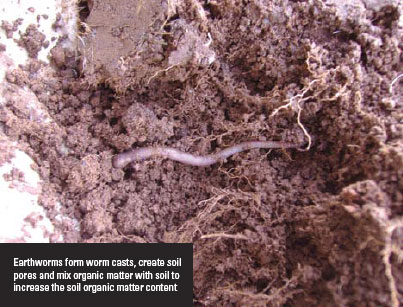|
|
Background
information
Standard soil fertility tests can provide a lot of information about your soils and differences between paddocks, no matter what your attitudes and preferences about using fertilisers. Soil nutrient deficiencies and imbalances can have a compounding impact — these soils are likely to have poor plant and root growth, low groundcover and litter levels and, therefore, a lower level of soil organic matter supporting fewer soil organisms such as bacteria, fungi and earthworms. Healthy biodiversity in soil organisms is also important to suppressing pathogenes which cause root disease.
This procedure deals with the issues of taking a soil test, interpreting the results, and identifying soil health problems such as soil acidity or sodicity. Fertiliser decisions, which are essentially about pasture growth and maximising profit, are dealt with in procedure 7.1 in Grow More Pasture.
|
|
 |
 |
Use soil tests to help monitor nutrient levels and soil health on different areas of your property
|
|
 |
Key decisions, critical actions and benchmarks
Even without a laboratory test, the number of earthworms present, and/or the ‘look, smell and feel’ test can give an indication about soil health. Tool 6.3 explains how to do these tests.
Take soil samples for testing
Tool 6.4 provides the directions for taking a soil sample for analysis at an accredited laboratory.
Standard soil tests provide an analysis of:
- Texture, colour, pH (usually in water
and in calcium chloride (CaC2)) and
electrical conductivity (EC)
- Phosphorus (P), Phosphorus Buffer
Index (PBI), potassium (K), sulphur
(S) Calcium (Ca), magnesium (Mg),
aluminium (Al) and sodium (Na)
- Calculations of cation exchange
capacity (and Na percent of cations), Ca/
Mg ratio and Al saturation.
Sub-soils can also be sampled to monitor
pH and aluminium. This is important
to determine if sub-soil acidity will affect
survival of sensitive species like lucerne
or phalaris seedlings. For each soil type/
paddock, take six subsoil samples from
a depth of 30–40 cm or the top of the B
horizon in duplex soils.
Interpreting soil tests
Interpreting soil tests as part of developing a fertiliser strategy is discussed in tool 7.3 in Grow More Pasture which considers the use of phosphorus, potassium, sulphur and nitrogen.
Tool 6.5 is provided to help interpret soil tests for any soil health problems (acidity, sodicity, salinity and trace elements) on your farm.
Signposts  |
Read
Soil Analysis, an Interpretation Manual: edited by K.J. Peverill, L.A. Sparrow and D.J. Reuter (CSIRO Publishing: Collingwood).
view: www.publish.csiro.au/pid/1998.htm
Sustainable grazing - a producer resource, explains how grazing management techniques can be used to achieve increased productivity and reduced methane emissions per hectare. There are 5 sections to this online resource:
- Running a sustainable grazing business
- Climate variability - using water wisely
- Healthy fertile soils
- Productive persistent and profitable pastures
- Grazing management
Visit: www.mla.com.au/research-and-development/environment-sustainability/sustainable-grazing-a-producer-resource
View
Making Better Fertiliser Decisions for Grazed Pastures in Australia: This product comes in two parts: an informative booklet and a CD for developing fertiliser maps. Use the Farm Nutrient Loss Index tool (on CD) to create a farm map and assess the likelihood of fertiliser applications being lost from the site. Get your free copy of the booklet and software tool by:
Five easy steps to ensure you are
making money from super phosphate.
This booklet is relevant for the
management of temperate legume-based
pastures grazed by sheep and beef cattle
on acid soils in southern Australia. Click here to download (1.4MB)
Soil Acidity: a wide range of fact sheets
covering soil health issues (not just acid
soils). Visit the NSW DPI website:https://www.dpi.nsw.gov.au/agriculture/soils/acidity
Soil Acidity - A Guide for WA farmers and consultants (published by DAFWA) can be downloaded at: http://researchlibrary.agric.wa.gov.au/bulletins/31/
Dispersive soils and their management can be downloaded at: http://dpipwe.tas.gov.au/Documents/DPIW_DSM_Manual_April2009.pdf
Australian Soil Resource Information System: ASRIS provides online access to the best publicly available information on soil and land resources in a consistent format across Australia It provides information at seven different scales:
- The upper three scales provide general descriptions of soil types, landforms and regolith across the continent.
- The lower scales provide more detailed information in regions where mapping is complete. Information related to soil depth, water storage, permeability, fertility, carbon and erodibility.
- The lowest scale consists of a soil profile database with fully characterised sites that are known to be representative of significant areas and environments.
Visit: www.asris.csiro.au/index.html
|

|